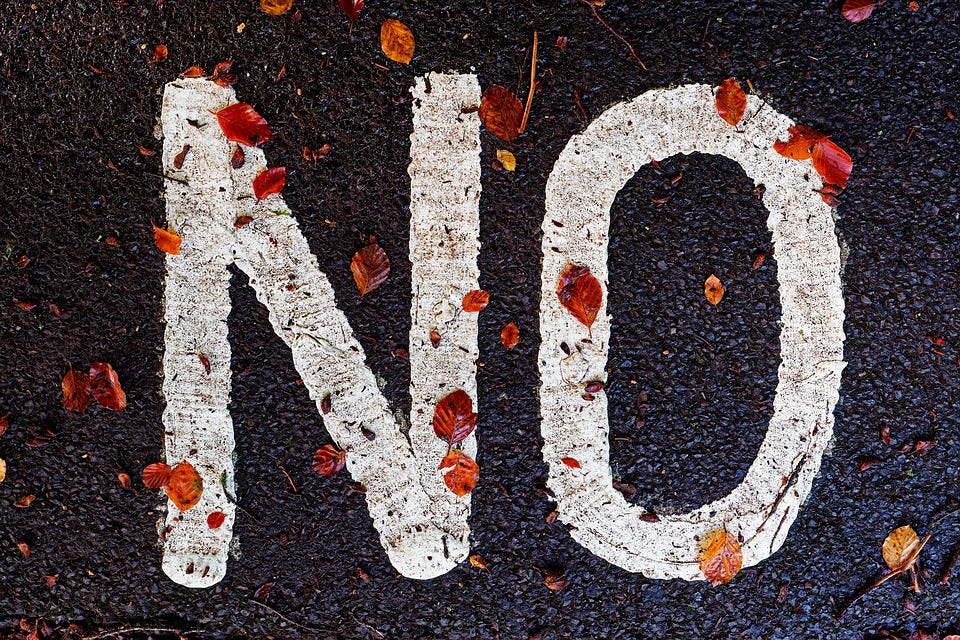How to Set Healthy Personal Boundaries: Navigating Life with Grace
The Crucial Role of Healthy Personal Boundaries
Do you like many of us struggle to say NO and feeling the need to explain yourself? Have you also like me said yes to invitations, requests you name it even though you really didn’t want to? If you have experience in any of these scenarios rest assured you aren’t alone and there is a way to get around these by learning how to set healthy personal boundaries.
In this life, navigating relationships, either at work or in our personal lives, requires a delicate balance. At the core of this state lies an often-overlooked yet essential concept known as personal boundaries. Boundaries are different for each one of us and can be due to cultural, societal and personal difference. Furthermore we will have boundaries that are specific to different settings as my boundaries with work colleagues will be different from my boundaries with childhood friends.
Setting boundaries - unwritten guidelines, give meaning to our expectations of ourselves and others in different kinds of relationships. These invisible lines, when they are well-defined and respected, safeguard our mental and emotional well-being. In this article, we will examine the art of setting healthy personal boundaries that becomes a skill that empowers us to foster self-respect, strengthen relationships, and maintain emotional balance.
Defining My Personal Boundaries
I had always heard about boundaries but it wasn’t until I understood what personal boundaries and for that matter mine was that it all made sense to me. Our personal boundaries are the intangible limits we set to protect our emotional and mental well-being. They serve as the compass guiding our interactions, helping us define what is acceptable and what crosses the line. Before I learnt these I would say I had no boundaries - yes I allowed people to talk and treat me like they wanted and though I most of the time felt frustrated and cried when I was alone at the disrespect I couldn’t master the courage to speak up.
Self-Reflection and Awareness
The break through came when my coach asked me some hard questions as to why I didn’t value and respect myself as I did others that I begun my search for building my self worth. See, setting healthy boundaries requires self-awareness something I thought I had because I was so into personal development but I realised there is a great difference in just knowing the theory and actually applying them. I got down to work with my journal and some deep questions on my values and what ticked me off, which by the help of my coach I was able to work through. I was given a task to start saying NO if asked to do something that wasn’t in alignment with my values. Not long after a moment came for me to exercise this and as hard as it was I managed to respond with a NO I won’t be able to do it. This was huge and scary but as I did it often I realised it become easy.
The Impact of Healthy Boundaries on Well-Being
Some people weren’t always happy and that was ok for me, I lost “friends” but I once read that if you set a boundary with someone and they get angry that is the more reason to set a boundary with them. In this we need to be clear about the expectations we have of ourselves and others, and what we are and are not comfortable with in specific situations. Healthy boundaries are not barriers; they are bridges to well-being. As I lost so called friends and ended a relationship during this healing period I realised that I hadn’t lost that much but I was finding myself and my true voice. I was living according to my values and not theirs. By establishing and maintaining clear boundaries, I experienced increased self-respect, found better relationships, and a sense of self and peace with who I am.
Recognising Boundary Violations
Recognising the signs of boundary violations is crucial. This can sometimes be missed when our emotions and goodness are preyed on. Some of these might be when someone says something mean but in a joking way, or when they ask for you to do something but make it seem as if they are giving you an option to do it or not. Boundary violations come in different forms, for me one of mine was identifying that in some cases when I was asked to be a part of something it wasn’t because I was really needed there but because my appearance showed the number and variety of people that belonged to the group. I used to feel happy when those invitations came but then was drained at the end of the event so when I realised that I could say NO and be by myself or with somebody else and feel good all the while, I made it a point to not go to places where I am just tolerated but rather to go to places where I am celebrated for me.
Handling Boundary Challenges
In a lot of cases setting boundaries will meet some resistance, like I mentioned earlier I lost relationships and this was hard but having a good supportive network around me and my determination to give myself the respect and love I was missing in those relationships kept me going. I started indulging in things I enjoyed to do alone or things I could do with others but still do by myself. It got me to discover a system which I now use as a guide (the self love guide) which I use to help my clients figure out how to love themselves and their own company. Maybe you might find going to the restaurant for a meal alone is too daunting, so would you rather go with someone/people who make you feel miserable just so you aren’t alone? I get we are all social creatures but is you mental and physical well-being worth being undervalued, unappreciated and disrespected? It’s hard yes and can be lonely but take that power back and responsibility for your well being and clearly state what you will and won’t tolerate.
Setting Clear and Assertive Boundaries
Setting boundaries is an art of clear communication while articulating our boundaries assertively, and fostering mutual understanding and respect. Being assertive involves expressing our feelings openly and respectfully. This is not the same as making demands, but rather encouraging people to listen to you. Setting healthy boundaries requires us to assert our needs and priorities as a form of self-care. Yes, self-care! We so easily forget how big this is but with our boundaries we cannot take care of ourselves in a way that gives us the capacity to properly take care of others. So we need to be very assertive about our boundaries by being clear in communicating our needs.
Regular Self-Check and Adjustment
It is worth noting that boundaries are not rigid; and they evolve according to the different stages we find our selves in. Through regular check-ins if you notice that a boundary is being violated you can redefine it and if it is being respected you can redefine that as well. The main point here is that we do our self assessment to determine how our boundaries are working for us. Setting boundaries is an essential part of our self care routine but being able to do this involves taking time out to care for ourselves.
Self-Care Practices for Boundary Maintenance
Seeing that nurturing healthy boundaries is inseparable from self-care here are some of the activities that have helped me in setting my boundaries,
Saying NO without further explanation. The trick I learnt here was if I had a request and my initial response wasn’t a hell yes, then it was a definite No.
Finding activities and projects to don on my own. I love baking so in the beginning when I was learning to love my own company I would plan weekends where I would try a different recipes every weekend. As I lived alone I would sometimes give this to neighbours too help me consume them but in the end I knew I spent time doing something I loved and respecting myself for it.
Expressing my feelings clearly and in the moment, I am an over thinker, and would go home after being with people analysing and stewing over how something they had said or did made me feel but now I have adopted the attitude that I need to let people know that was a “below the belt” move, I let them know I didn’t appreciate what happened and would appreciate them not repeating. This hasn’t always gone smoothly and I have had a number of times where a manager has told me they weren’t going to apologise because that wasn’t what they intended. I had replied “I am telling you how it makes me feel that’s it.” Under normal circumstances they will accept and apologise but in this case they didn’t but the most important is I spoke up and so they know not to repeat the next time.
Managing my expectations. In the above example I didn’t get the apology I expected even though she had violated my boundary. It has become a habit for me to say NO, express my feelings and needs without me fully expecting the other party to be in agreement in that sense what I get out of these is that I have respected myself enough to stand up for my mental and emotional well-being. I have stayed true to my values and also clearly communicated my needs and that is what matters to me. I can only control my reactions not theirs.
The Gift of setting personal boundaries
As we conclude this very powerful subject on how to set healthy personal boundaries, I would like to encourage you to remember that setting and maintaining healthy boundaries is an ongoing journey of self-discovery and empowerment. As we implement these strategies and more, we create a safe space to safeguard our well-being and foster a sense of respect and balance that allows us to navigate life's complexities with strength and adaptability. I know it is not easy but trust me that with time and you prioritising yourself like you would do others you will feel better and then attract people who appreciate you into your life - gift you give to yourself and others. It starts with you speaking up for yourself and wanting that much love and respect for yourself. Remember you are fearfully and wonderfully made and beautiful exactly as you are.
Journal prompt: What do I struggle to say NO to and why?










